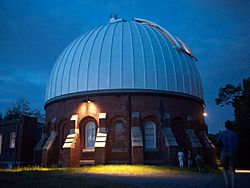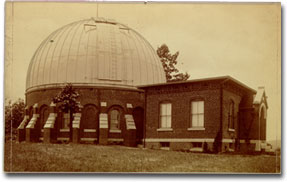McCormick Observatory facts for kids
Quick facts for kids Leander McCormick Observatory |
|||||||||||||||||||||||||||||||||
|---|---|---|---|---|---|---|---|---|---|---|---|---|---|---|---|---|---|---|---|---|---|---|---|---|---|---|---|---|---|---|---|---|---|

Leander McCormick Observatory at night
|
|||||||||||||||||||||||||||||||||
| Organization | Department of Astronomy, University of Virginia | ||||||||||||||||||||||||||||||||
| Location | Albemarle County, Virginia, US | ||||||||||||||||||||||||||||||||
|
Coordinates
|
38°1′58.2″N 78°31′20.4″W / 38.032833°N 78.522333°W
|
||||||||||||||||||||||||||||||||
| Altitude | 264 meters (866 ft) | ||||||||||||||||||||||||||||||||
| Website McCormick Observatory |
|||||||||||||||||||||||||||||||||
|
|||||||||||||||||||||||||||||||||
The Leander McCormick Observatory is a special place where people study stars and space. It's one of the astronomical observatories run by the Department of Astronomy at the University of Virginia. You can find it just outside Charlottesville, Virginia, on top of a hill called Mount Jefferson. The observatory is named after Leander J. McCormick, who gave the money to build its powerful telescope and the building itself.
Contents
History of the Observatory
How It Started
Leander McCormick came from a family of inventors. His father, Robert McCormick, invented a machine called a reaper that helped farmers harvest crops. Leander's brother, Cyrus H. McCormick, made the reaper famous and started a big company. The McCormick family later moved to Chicago to build their business, which eventually became International Harvester.
In 1870, Leander McCormick wanted to donate the largest telescope in the world to his home state of Virginia. However, money problems after the American Civil War and a big fire in Chicago delayed his plans. For a while, he thought about giving the telescope to Washington College. But thanks to Charles Scott Venable, a professor at the University of Virginia, McCormick decided to give his amazing gift to the University of Virginia in 1877. In 1878, the University officially received the telescope. Later, in 1881, McCormick donated more money to build the observatory building.
Building the Telescope and Observatory
The main telescope is a 65-centimeter (about 26-inch) refractor. It was built by Alvan Clark & Sons in Massachusetts, who were known as the best telescope makers at the time. When it was finished, it was one of the biggest telescopes in the United States and the second largest refractor in the world. It was very similar to another large telescope at the U.S. Naval Observatory in Washington.
A cool fact: In 1877, before the McCormick telescope was even fully installed, Alvan Clark used its lens to confirm the discovery of the moons of Mars! This happened just one night after they were first seen by another astronomer using the Naval Observatory telescope.
The telescope and the observatory building were finished in 1884. They were officially opened on April 13, 1885, which is Thomas Jefferson's birthday. The observatory's dome, which covers the telescope, was 45 feet wide. It was the largest dome in the world when it was built and had a special design with three shutters.
Early Discoveries and Research
Even before the telescope was fully ready, astronomers at the observatory made important observations. On December 6, 1882, they watched the Transit of Venus, which is when Venus passes directly in front of the Sun.
Under its first director, Ormond Stone, the observatory began mapping the positions of stars in the southern sky. They also studied double stars (two stars orbiting each other) and distant clouds of gas and dust called nebulae.
In 1914, the second director, Samuel Alfred Mitchell, started a long-term project. They used photography to measure the distances to nearby stars. This is called measuring stellar parallax. This important work continued for more than 80 years, and the McCormick Refractor helped determine the distances to thousands of stars. Other scientists like Peter van de Kamp and Alexander N. Vyssotsky also used the telescope to study how many and what types of stars are in different parts of the sky. This helped them learn about the size and shape of our own galaxy, the Milky Way.
The Observatory Today
Today, the Leander McCormick Observatory is mainly used for teaching students and for public events. It has a museum where you can learn about the history of astronomy at the University of Virginia. The main research of the Astronomy Department now happens at another observatory called Fan Mountain Observatory.
Since the 1880s, the McCormick Observatory has also been taking daily weather observations. It has been part of the National Weather Service's weather observation program since it began in 1890.
The telescope at McCormick Observatory is special because it's the largest Alvan Clark refractor that is still on its original mount. This means it's a true piece of history that still works!
See also
 In Spanish: Observatorio Leander McCormick para niños
In Spanish: Observatorio Leander McCormick para niños
- List of astronomical observatories
- List of largest optical refracting telescopes




